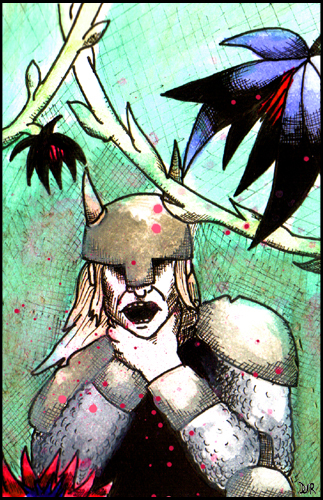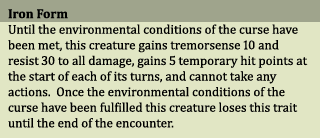Posts Tagged ‘Conan’
Queen of the Black Coast – Part Two
April 17, 2012Instead of a classically defined monster, I thought I would use this installment of Monsters of the Hyborian Age to look at one of the obstacles Conan faces in Queen of the Black Coast and what is probably one of the most iconic species of flora in Howard’s writing – the black lotus (plus a bonus lotus). In keeping with the way the black lotus is used in the story, I think the best way to represent the plant is as a fantastic terrain feature (I could have gone with a natural hazard trap, but there didn’t seem to be enough mechanical meat to the black lotus to justify this).
As far as I can tell three other types of mystical lotus plant are mentioned in the chronicles of Conan (the purple, yellow and golden lotus – which makes the lotus a bit like the Hyborian equivalent of kryptonite), but only the black and purple varieties are suitable for D&D fantastic terrain. The juice of the golden lotus and dried yellow lotus incense are better used in-game as magic items. When Monsters of the Hyborian Age is finished, I would love to do a post with a few of the magic items Conan encountered during his adventures.
For the summary of Queen of the Black Coast, as well as the Winged One monster, click here.
Spoiler Alert! All of these Hyborian age posts are going to be filled with spoilers. From the summary, to the monster stats they are going to ruin any surprises as to what the monster is, when it appears in the story and how and why it is killed. You’ve been warned.
Fantastic Terrain
“He recoiled, recognizing the black lotus, whose juice was death, and whose scent brought dream-haunted slumber. But already he felt a subtle lethargy stealing over him.” – Robert E. Howard, Queen of the Black Coast.
The lustrous, heavy flowers of the black lotus cling to rocks and other vegetation and can be combined with any other mundane terrain feature. Any creature that ends its turn on or adjacent to a square of black lotus inhales the sinister plant’s narcotic pollen and is slowed (save ends). Creatures that fail their first saving throw become unconscious (save or the target takes damage ends). Unconscious creatures receive strange, disturbing dreams that are often prescient or retro-cognitive concerning the area the black lotus grows.
Creatures immune to poison or who do not breathe are unaffected by the pollen of the black lotus.
Purple Lotus
“Tsotha displayed a broad ring of curious design from his finger. He pressed his fingers together and on the inner side of the ring a tiny steel fang darted out like a snake’s tongue.
‘It is steeped in the juice of the purple lotus which grows in the ghost-haunted swamps of southern Stygia,’ said the magician. ‘Its touch produces temporary paralysis…” – Robert E. Howard, The Scarlet Citadel.
Clumps of purple lotus can grow in any wet or swampy location. The juice of the plant’s sap is a powerful paralytic, which makes weapon play dangerous in their midst. A creature in a square with purple lotus that takes physical damage from an attack is immobilized (save ends). Creatures that fail their first saving throw become paralyzed (save ends).
Creatures immune to poison are unaffected by the sap of the purple lotus.
Notes
“Hey… black lotus… Stygian… the best!”
I couldn’t resist.
This took me a little longer than expected (maybe I should have used some of that black lotus). I am determined to have an illustration for each Monsters of the Hyborian Age entry, but truth be told I was just not that motivated to make a picture of a flower. In the end I came up with a composition that didn’t bore me to tears, and I’m pretty happy with the visualization of the lotus’ spores, but I really hate what I did with the background…
Queen of the Black Coast – Part One
March 19, 2012It’s been far too long since I returned to the stories of Robert E. Howard, and now that a new edition of D&D looms on the horizon, I have something of a deadline to finish this project.
Queen of the Black Coast is one of my favorite Conan tales. It shows a different, more complicated side to the Cimmerian and features a powerful and engaging female character who is at least Conan’s equal (and it’s pretty easy to argue that Howard positions Belit as Conan’s superior). There’s a real epic quality to the story, and the vast span of time it covers begs the imagination to fill in the blanks. It’s not surprising Queen of the Black Coast also features some very inventive monsters (and its strange were-creatures may be one of the inspirations for D&D’s cornucopia of lycanthropes).
Spoiler Alert! All of these Hyborian age posts are going to be filled with spoilers. From the summary, to the monster stats they are going to ruin any surprises as to what the monster is, when it appears in the story and how and why it is killed. You’ve been warned.
Summary
Howard begins his tale with Conan in the thick of it, hurtling down the streets of an Argossean port city on a black stallion towards the docks. One step ahead of an angry magistrate and his men, Conan rides to the very edge of the wharf and leaps from his saddle onto the deck of the Argus, a trading galley just pulling away from the dock. After a few threats from the Cimmerian, the ship’s master agrees to take Conan along. The waters the Argus must ply are thick with pirates and Conan’s experienced blade defending the ship will put the rest of the sailors at ease.
The captain’s fears are justified, for once in Kushite waters, the Argus is set upon by the pirate ship Tigress, and her infamous master, Belit – called Queen of the Black Coast. The Argus puts up a valiant fight, but it is no match for the Tigress and the merchant vessel is soon overtaken and boarded. Bloody carnage breaks out and Conan, knowing this is his last stand, is determined to take as many of the pirates to hell with him as he can. There is something about the exotic northerner’s naked ferocity 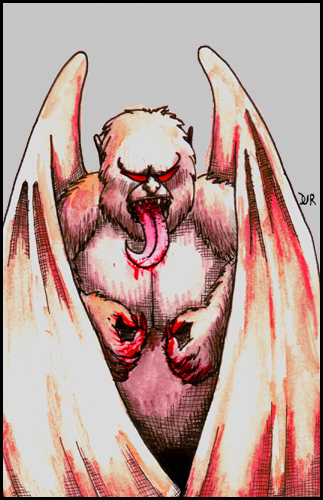 and bloodlust that intrigues Belit. She orders her men to spare Conan and offers him the chance to join her bloody rampage on the high seas. Conan is likewise drawn to the Shemite woman, not just for her unsurpassing beauty, but by the raw power of her unbridled passion. With the crew of the Argus dead, Conan joins Belit.
and bloodlust that intrigues Belit. She orders her men to spare Conan and offers him the chance to join her bloody rampage on the high seas. Conan is likewise drawn to the Shemite woman, not just for her unsurpassing beauty, but by the raw power of her unbridled passion. With the crew of the Argus dead, Conan joins Belit.
Time passes. The ferocity of Conan and Belit’s love is equalled only by the destruction the pair wreaks. The Queen of the Black Coast and her icy eyed consort become legends, their names cursed by the survivors of the Stygian ships laid waste by the Tigress. In an outburst of fevered desire, Belit promises Conan that her love burns so fiercely that not even death can keep her from the Cimmerian’s side.
Guided by rumours and forbidden lore, Belit orders the Tigress up an unnamed river, deep into an impassable, toxic jungle. The waters of the river become poisonous, and have a strange effect on the surrounding flora and fauna. Pressing on, the crew finds the ruins of a city older than mankind itself, whose former occupants Belit names ‘the old ones’. Landing, the pirates sack the ruins, finding both deadly traps and glittering mounds of treasure. Among these is a necklace with weird gems the color of clotted blood. Seized with a kind of madness, Belit becomes obsessed with the necklace, and begins acting strangely. What’s worse, the old ones are not as extinct as the pirates had hoped. The last of their kind still haunts the city, a degenerate, winged, ape-thing, who sabotages the Tigress’ supply of fresh water.
Under the effect of the necklace, Belit is unmoved, caring only for her newfound treasures. Conan, more sober minded, takes a small contingent of warriors into the jungle in search of fresh water. Tragedy strikes Conan, who succumbs to the sleep of the pollen of the black lotus plant. While he slumbers he is tormented by visions of the city’s long and terrible history. He awakens to find that the winged creature has slaughtered the entire pirate crew, including his beloved Belit, who hangs from the mast of the ship, strangled by the cursed necklace.
Filled with cold, black, fathomless rage, Conan climbs a ruined pyramid and awaits the monster for a chance at revenge. The Cimmerian is first set upon by the winged creature’s servants, a pack of were-hyenas the monster cursed in the long past. Conan is victorious, but during the melee he becomes pinned under a piece of rubble. Seeing its opportunity, the winged creature swoops down to finish Conan off, but Belit is true to her word, and her apparition appears, blocking the path between her murderer and her lover. The monster is momentarily stunned, Conan frees himself and in the bat of an eye cleaves the beast in twain.
Silent and grief stricken, the tale ends with Conan watching the Tigress sail away, alight with the flames of Belit’s funeral pyre staining the horizon.
The Winged One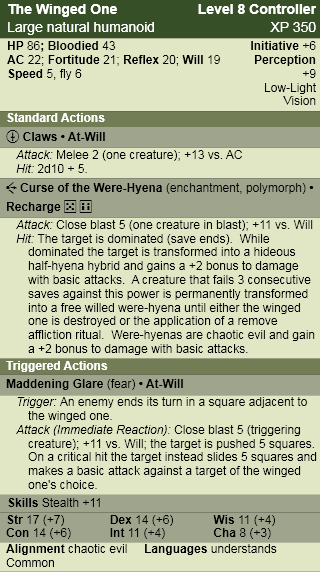
“With fearful speed it was rushing upon him, and in that instant Conan had only a confused impression of a gigantic man-like shape hurtling along on bowed and stunted legs; of huge hairy arms outstretching misshapen black-nailed paws; of a malformed head, in whose broad face the only features recognizable as such were a pair of blood-red eyes.” – Robert E. Howard, Queen of the Black Coast.
Lore
Nature 15: Superstition holds that the souls of evil men and women are imprisoned in the bodies of apes as punishment for their crimes. The vilest of these sprout wings so they can take to the air and continue to torment the living.
Nature DC 20: In the dawn of prehistory existed an exalted race of winged beings known only as ‘the old ones’. Their people reached its cultural zenith before humankind had yet crawled out of the muck, but like all civilizations, was destined to fall. A series of natural disasters rocked the old ones’ city state and polluted their drinking water with a foul substance. Those who did not die were changed, and after generations of mutation and degeneration, the twisted creatures fell on each other in a frenzy of infighting and cannibalism. Those few winged ones who still cling to hateful life are incredibly old, and know some of the weird magics of their ancestors.
The Winged One in Combat
Though devolution has robbed the winged ones of much of their people’s former intellect, they have an evil cunning that makes them dangerous foes. Before engaging an enemy directly, a winged one prefers to use distraction and sabotage (often with the aid of its servants) in an attempt to divide their enemies into more manageable groups. Often a winged one will destroy an invader’s supply of food and water, forcing them to drink from the polluted river or face the poisonous denizens of the surrounding jungle. When combat breaks out, a winged one always tries to curse the strongest looking warrior, flying off to a safe distance so it can enjoy the spectacle of the were-hyena attacking and devouring former friends.
Encounters
Winged ones haunt the jungle ruins of their former civilization, torturing themselves by watching their race’s greatest achievements slowly crumble to dust. A winged one curses any who dare intrude on its lonely vigil, transforming them into bestial were-hyenas. These creatures, as well as packs of gnolls, are often mystically bound to the area and answer the winged one’s call. The winged one reserves its bitterest rage for those foolish enough to try and steal from the temples and palaces of the old ones. The creature will stop at nothing to track down and murder these thieves, displaying their corpses as a warning to future delvers.
Notes
Like Thurgra Khotan, I think the History skill is more appropriate for Lore checks regarding the winged one, instead of following the 4e convention and using Nature checks for all creatures with the natural origin.
Inspired by the work of Tony DiTerlizzi (especially during his Planescape years) I tried my hand at coloring the illustration with traditional watercolors rather than using digital color as I have in the past. I think I need a bit more practice, but I’m pleased with the results.
Shadows in the Moonlight – Part Two
July 16, 2011The Shadow in the Trees is the second creature from Robert E. Howard’s story, Shadows in the Moonlight. For the summary of that tale, as well as the iron shadow monster theme, click here.
This is also the second of Howard’s man-eating grey apes that I’ve featured in this series. The first, Thak, appeared in Rogues in the House (and before I’ve finished with Howard’s stories, there will be at least one more).
Spoiler Alert! All of these Hyborian age posts are going to be filled with spoilers. From the summary, to the monster stats they are going to ruin any surprises as to what the monster is, when they pop up in the story and how and why they are killed. You’ve been warned.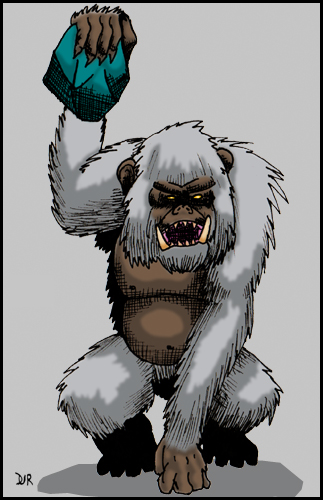
The Shadow in the Trees
“In general outline it was not unlike a man. But its face, limned in the bright moonlight, was bestial, with close set ears, flaring nostrils, and a great flabby-lipped mouth in which gleamed white tusk-like fangs. It was covered in shaggy grayish hair, shot with silver which shone in the moonlight, and its great misshapen paws hung nearly to the earth.” – Robert E. Howard, Shadows in the Moonlight.
Lore
Nature DC 15: Grey apes are a brutal and savage species of carnivorous primate that dwell in lonely mountains and hills. Their minds are more developed than true apes, and they often employ crude tools and weapons, though they are no less capable of ripping an enemy apart with their bare hands. It is prophesized that grey apes will one day evolve into a species that will challenge humanity for dominance.
Nature DC 20: Some grey apes have honed the skill of rock throwing to such a degree that they can rebound a single stone between two targets. These apes hide caches of projectiles throughout their hunting grounds, each carefully chosen for its weight and balance. Against large groups of enemies, grey apes hurl massive chunks of brittle stone that explode in a shower of painful and debilitating shrapnel.
The Shadow in the Tree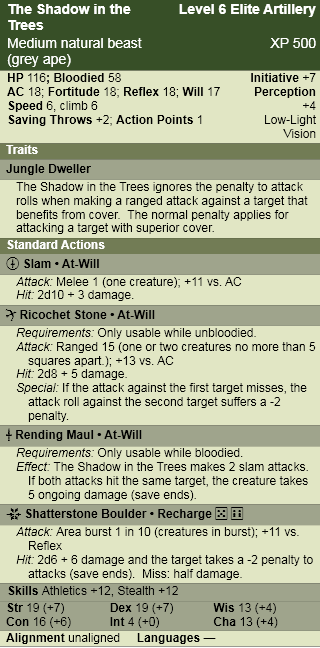 s in combat
s in combat
The Shadow in the Trees is a wary and cunning hunter. From behind a barricade of natural cover, or difficult terrain, it surprises its prey with a veritable barrage of hurled missiles. Only when its broken victims have stopped screaming, does the carnivorous ape move in to feed.
Like all grey apes, the Shadow in the Trees is prone to fits of bestial anger. When wounded, the ape is possessed with a homicidal fury, dropping its weapons and abandoning caution to rip and tear the source of its pain to bloody shreds.
Encounters
The shadow in the trees is drawn to ancient, vine choked jungle dungeons, where crumbling walls and loose flagstones provide the creature with ample ammunition. These forays bring the ape into contact with a wide assortment of strange creatures. In such an environment, the adaptable grey ape will utilize mindless denizens, like oozes and undead, as a natural bulwark against attackers. In turn, more organized creatures, like bugbears and gnolls, are eager to press a creature like the Shadow in the Trees into service with steady bribes of raw meat.
Notes
My main goal with the Shadow in the Trees was to extrapolate on the mechanical design of Thak, the first grey ape, without making a carbon copy. I like that Thak is essentially two creatures in one – a leader who relies on traps who transforms into a straight hand to hand brute when it becomes bloodied. That way, halfway through the fight, the creature’s altered tactics keep the players on their toes.
I continued that theme when I made the Shadow in the Trees. It’s an artillery creature that avoids melee characters, who transforms into a hand to hand brute that rushes into the thick of the fight (cribbing its bloodied attack from Thak which I thought provided a nice mechanical thread between the two monsters). The coolest part is how well this approach reflects the events of the story (the beast spends most of the tale hurling rocks from the concealment of the forest, only to emerge and confront Conan directly when its volatile rage gets the better of it).
When I create the next grey ape (which is about 8 stories away – so not anytime soon), I’m definitely going to continue with this pattern. One of the things I love about the 4e bloodied mechanic is that it lends itself so well to these Jekyll and Hyde type transformations (though I guess in the case of the grey apes it’s Hyde and Hyder).
Shadows in the Moonlight- Part One
June 21, 2011There is a lot for DMs to learn in Shadows in the Moonlight. In D&D terms, the island where the action of the story takes place is definitely a location based adventure, but it is also an amazing example of what game designers call a ‘living dungeon’ – one where the actions of the PCs influence the actions of the NPCs and both react to the island’s set encounters.
This story has the added bonus of a female character who subtly subverts the whole damsel in distress motif that was bothering me a few stories ago. Yes, Olivia is a damsel in distress, but she’s also capable of driving the plot forward on her own, and is more than just a prize to be won by the Cimmerian at the end of the story. In fact, although told in the third person, the story is obviously from Olivia’s point of view, making her the reader’s ‘eyes’.
Spoiler Alert! All of these Hyborian age posts are going to be filled with spoilers. From the summary, to the monster stats they are going to ruin any surprises as to what the monster is, when they pop up in the story and how and why they are killed. You’ve been warned.
Summary
Howard’s tale begins with Olivia, daughter of the King of Ophir, sold into slavery because she would not marry a King of Koth, fleeing her former master, the Hyrkanian Shah Amurath. On the swampy boundary of the Vilayet Sea, Shah Amurath reaches his quarry. As fate would have it, the salt marsh is also the temporary refuge of Conan, himself fleeing from Shah Amurath’s troops who had recently slaughtered the Cimmerian’s rogue mercenary army, the Free Companions. Mad with starvation and a burning desire for revenge, Conan throws himself at Amurath. The Hyrkanian’s superior weapons and armour pale before the furious onslaught of the barbarian, and in a few bloody moments of mad butchery he is cut down. His bloodlust sated, Conan returns to his senses and introduces himself to Olivia. Soon after, the pair decides to escape in a stolen rowboat before they are caught red handed by the deceased Shah’s men.
After a day of hard rowing, Conan lands the craft on a small deserted island to rest and gather some food. It isn’t long before they are ambushed by a huge hunk of hurled stone. Conan investigates, and after a few moments draws his weapon, grabs his companion and slowly backs out of the trees. Whatever it is that had unnerved the barbarian, Olivia cannot see it.
Moving through the island’s grassy hills, the two stumble upon the ruins of an ancient building. Eager to get as far from the jungle as possible, Conan and Olivia enter. Inside they find the hall of the long, low building is filled with incredibly lifelike iron statues of unsettling humanoids. The sculptures are disturbing, but poking and prodding reveal them to be as solid as they appear. Safe from their mysterious jungle stalker, Conan and Olivia drift off to sleep.
Instead of blissful rest, Olivia is plagued with an incredibly realistic nightmare. She sees the building as it once was, filled with the humanoids depicted in the statues. They torment a beautiful angelic figure chained to a pillar. To no avail, the angel creature wails to the heavens. A moment later, the dark humanoids open its throat in bloody sacrifice. Suddenly, the skies open wide and a being that could only be described as an exquisite and terrible god steps down among the savages. Cradling the body of its slain progeny, the god pronounces a powerful curse in its alien tongue. The humanoids freeze, transfixed, their bodies metamorphosed into solid iron. The deity then points to the moon, hanging in the night sky, and departs.
Olivia wakes screaming, and despite Conan’s protests that the statues are harmless, manages to convince the barbarian to leave at once. As frightened as she is about the iron figures coming back to life, Conan is more concerned about whatever lurks in the concealing jungle, so the pair take refuge on the island’s rocky cliffs.
The next day, from their high vantage point, Conan spies a pirate ship pulling ashore, spilling its ragtag occupants in search of supplies. The barbarian knows the ship is the best opportunity to safely leave the island and be rid of the Hyrkanians, so he hatches a scheme. In case his plan doesn’t work, Olivia hides while Conan confronts the pirates of the red brotherhood.
Unfortunately, the leader of the pirates is already well acquainted with Conan, and has a score to settle. Outnumbered, Conan goads the pirate captain into single combat, and handily slays him. Before he can parlay the victory into something more, an overzealous pirate brains Conan with a sling stone. Without the iron hand of a leader to guide them, the red brotherhood argues amongst themselves over the fate of the unconscious and bleeding Cimmerian.
Unaware of Olivia, the pirates bind Conan and drag him back to the ruins, where they set up camp for the night. Fearing the coming evil of the moonrise, Olivia braves both the jagged cliff face and pursuit by the shadowy stalker that has hounded them since their arrival. Inside the ruins, she creeps past the sleeping and drunken pirates to free Conan and escape.
They do not make it far when they finally meet Olivia’s pursuer face to face. Their mysterious assailant emerges from the shadows; a bestial man-eating grey ape. It was time for a reckoning in the only manner that Conan knew how. Barbarian and beast clash, but with the advantage of steel, Conan leaves the ape a broken and dismembered corpse.
The jungle brute was dead, but the island had yet to play its final hand. From the ruins came a series of bloodcurdling screams, the clash of steel, and the sound of unbridled butchery. Olivia’s dream had come to pass – the moonlight had just reached the crumbling building. Not eager to see the nightmare first hand, Olivia and Conan take flight to the pirate’s abandoned ship.
The morning light brings a small group of wounded and shaken pirates who managed to escape the massacre with their lives. Conan allows them to board what was once their ship – provided they acknowledge him as their captain. With a ship and a crew to replace the Free Companions, Conan was ready once again to plunder his way to vengeance across the inland sea.
Iron Shadow
“They were statues, apparently of iron, black and shining as if continually polished. They were life-sized, depicting tall, lithely powerful men, with cruel hawk-like faces. They were naked, and every swell, depression and contour of joint and sinew was represented with incredible realism. But the most life-like feature was their proud, intolerant faces.” – Robert E. Howard, Shadows in the Moonlight.
When the gods are angered the world trembles. When there is a blasphemy so obscene it demands justice, such as the ritual murder of a deity’s demigod offspring, the gods do not act through proxies, and iron shadows are left in their wake.
Iron shadows are the product of an ancient divine curse, transformed into metal statues to guard over the site of their cosmic crime until the end of time. As such, they are usually found in the crumbling remains of prehistoric dungeons, the ruins of primordial temples, and on blasted mountain peaks shunned by all sentient races. They are immobile, forced to watch without being able to act, until an environmental condition, laid out at the time of their cursing is satisfied. Such a condition could be anything from the light of the moon to a breath of air in a subterranean chamber, but once it has been met, the iron shadows are temporarily transformed back into flesh and blood creatures; free to release centuries of bottled hatred on any unfortunate enough to cross their path.
Only the gods themselves know why they would allow the objects of their curse even the briefest freedom from punishment. Perhaps the terror iron shadows invoke serves as a reminder to the world the consequences for the ultimate blasphemy.
Only the most depraved of the thinking races have incurred this divine curse, including black ones, derro, drow, gnolls, goblins, humans, kuo-toa, and troglodytes. Some iron shadows are so old that they have outlived their decadent civilizations, and even the names of their species are lost to the sands of time.
The iron shadow theme adds an element of lurker to any monster, and works best on a group of creatures in a set-piece encounter that reinforces the blasphemous act that offended the divine. Alternatively, iron shadow themed monsters work well in an area the characters must travel through frequently, and have been lulled into a false sense of security by the statues’ prior inactivity.
Skill Modifications: +2 bonus to Stealth, and a +2 bonus to one of the following knowledge skills – Arcana, Dungeoneering, History or Religion.
Traits
All iron shadows gain the following trait, which simulates their cursed sta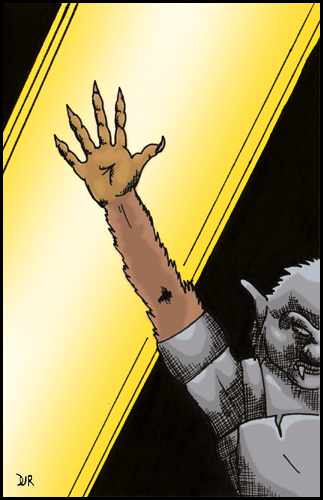 te:
te:
Attack Powers
The nature of their curse means that Iron Shadows most often attack from surprise, surrounding their foes and bringing down the weakest targets as quickly as possible. Although the survivors of such an onslaught often flee, the divine magic of the iron shadows’ curse binds them to the area and prevents pursuit.
Fearsome Aspect
This power emphasises the sudden and frightening nature of an iron shadow attack. It works best in an encounter area that directly blocks the characters’ objective, since all or some of the party may be forced to flee.
This power makes the opening attack of a lurker even more devastating, or adds an element of lurker to any other monster role.
Relive the Nightmare
When added to a lurker (or other creature with bonuses against targets that grant combat advantage), this power helps to increase damage potential. Relive the nightmare also gives the dungeon master the opportunity to describe the events surrounding the iron shadow’s curse, and inject pieces of narrative into the combat.
Utility Powers
Iron shadow utility powers focus on keeping lurkers and artillery alive long enough to cause the maximum amount of damage.
Centuries in Iron
Over time, some iron shadows have learned to harness the deific curse to their own advantage. This protective power is especially useful for lurkers and artillery that are prone to succumbing to the effects of focused damage.
Palpable Hatred
This power helps to protect artillery from melee combatants, keep skirmishers mobile and prevent lurkers from being surrounded by foes.
Notes
Wow, I’ve never made a theme before and I have to admit it was a lot more work than I thought it would be (much more than creating a single monster, which in hindsight makes sense). Of course, the fact that the battle with the monsters isn’t directly described in the story didn’t help either. Still, I think making a theme to represent the isle of iron statues was definitely the right choice. This way, almost any creature can be turned in to what amounts to an iron gargoyle – which I think has a lot more utility than a single similar monster.
I’m pretty sure that the statue creatures in the story are the black ones from the Pool of the Black One (their physical description is comparable as well as the strange green stone of their buildings). I find the presence of these creatures in both stories very interesting for what it means about the setting of the Hyborian age. In his essays, as well as the Conan and Kull stories, Howard writes at length about the ancient civilizations of the serpent people, Stygia and Acheron, but he makes no mention of the black ones. Being present as far west as the Atlantic, and as far east as the Vilayet, suggests remnant pockets of what at one time must have been a much more widespread race (plus the green stone of the city of Xuthal in the south suggests that they may have been the original builders), probably incredibly old even in Kull’s time, before Atlantis sunk beneath the waves. A quick internet search reveals I’m not the first person to question the relation between these stories, but it’s still an interesting point to ponder nonetheless.
Rogues in the House
May 28, 2011Beyond being a great crime/horror story, Rogues in the House is especially interesting to gamers as an example of the literary roots of D&D’s city adventures. While the obvious choice for such inspiration is Fafhrd and the Grey Mouser’s adventures in Lankhmar, I think that Rogues in the House provides a darker and grittier counterpoint to Fritz Leiber’s more whimsical tales. Thievery, corruption, political intrigue, backstabbing, and assassination – this story has more than enough fodder for any DM looking to mine ideas for urban adventures.
Spoiler Alert! All of these Hyborian age posts are going to be filled with spoilers. From the summary, to the monster stats they are going to ruin any surprises as to what the monster is, when they pop up in the story and how and why they are killed. You’ve been warned.
Summary
The events of this tale take place not long after The Tower of the Elephant, featuring a somewhat wiser Conan, though no less wild and dangerous.
The story begins with the subtle and deadly political manoeuvrings of Murilo, a young and ambitious noble selling the secrets of his city to the enemy, and Nabonidus, a Red Priest who uses his religious position to control the city’s ruler for his own personal gain. Nabonidus sends Murilo a message, a gilded box with the ear of one of the nobleman’s confederates. Clearly, Murilo has been marked for death. In need of a hired sword to assassinate the Red Priest before his enemy can strike, Murilo seeks out Conan, who has earned a dangerous reputation in the city’s slum.
Luckily for Murillo, Conan has been imprisoned for the murder of a different priest (who happens to be a double crossing fence), and is in need of a favour to avoid the headsman’s axe. Conan agrees without hesitation to Murilo’s bargain – in exchange for his freedom he will kill Nabonidus before the sun rises.
Unfortunately for both men, the guard that Murilo had bribed to free the Cimmerian is arrested before completing his task. Overcome with panic, Murilo grabs a sword and heads to the Red Priest’s estate to deal with Nabonidus personally. Once there, he finds the guards have already been slain, yet not by human hands. Eventually he finds Nabonidus slumped over a table, his features hidden by the enveloping folds of his signature red cloak. Stealthily Murillo moves to strike, but the figure wheels around, revealing not the Red Priest but a hairy monster that quickly overpowers the noble and knocks him unconscious.
Meanwhile, Conan has escaped prison on his own, crushing his jailor’s skull with a joint of beef he had been eating (a classic move every warrior since has dreamed of repeating). Although there is nothing holding him to his bargain, he keeps it anyway, sneaking into Nabonidus’ abode through the sewers. There he encounters the first of the Red Priest’s traps – an iron portcullis that swings down, trapping the barbarian in the estate’s dungeons. It is not long before he runs into the shaken Murilo, and with little other choice, the two press on to find and slay their captor.
Eventually they cross paths with none other than Nabonidus himself, recovering from a blow to the head and trapped within his own dungeon. After some back and forth a truce is called (against Conan’s instincts to simply kill the Red Priest and be done with it). Nabonidus and Murilo agree to forget their transgressions against one another and cooperate in order to escape. It seems that the beast the young noble encountered wearing Nabonidus’ robe is Thak, the Red Priest’s pet grey ape. Nabonidus raised the creature from a cub and trained it to be his bodyguard and servant, but it turned against him this night and slew the rest of his minions.
Nabonidus leads the pair to the only exit from their dank prison, a door that leads back up to the building above. Before they leave, Nabonidus uses a series of periscopes he has hidden in the dungeon to spy on the chamber above, confirming his worst fears. Thak is waiting patiently for them. But what is worse than facing the creature’s brute strength is that he has mastered the household’s deadly traps. The Red Priest assures Conan and Murilo that to open the door while the ape watches is certain death.
While the trio debates their next course of action, another faction enters the tale, inadvertently breaking the stalemate. Through the periscope Nabonidus detects a group of nationalists stealing into the chamber, weapons drawn, the second party of the night with the Red Priest’s assassination on their minds. Surprising them as it had Murilo earlier; Thak catches them off guard and activates one of Nabonidus’ pitiless traps. Before they can react, t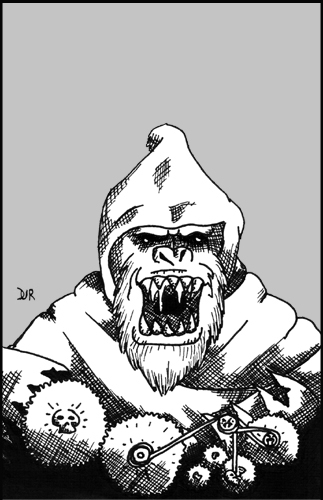 he nationalists are levelled by grey lotus powder.
he nationalists are levelled by grey lotus powder.
Just as his master had taught him, Thak drags away the bodies to conceal his crime. Knowing they will have few opportunities, Conan, Nabonidus and Murilo sprint into the room before the ape returns. The trio may have avoided the deadly trap, but escape from the killer ape is another matter entirely. In order to finally vanquish their tormentor Murilo acts as a decoy while Conan waits in ambush. Barbarian and beast meet in a contest of unbridled primal fury, with Thak ultimately succumbing to the repeated blows of Conan’s poniard.
However, there is one final play to be made. Nabonidus seizes the opportunity to do away with his enemies by grabbing the pull cord for one of his unsprung traps. Conan and Murilo completely in his power, the Red Priest gloats over his victims. But his triumphal celebration is premature. Moving like a panther, Conan grabs a nearby stool and hurls it at Nabonidus’ head with such force that it snaps the man’s neck.
The pair finally leaves the accursed house of the Red Priest – Murilo to his political ambition, and Conan to the unencumbered adventure of the highway.
Thak
“The body was thick, broad and stooped. The unnaturally wide shoulders had burst the scarlet gown… The face peering from the scarlet hood was utterly bestial, and yet Murilo realized that Nabonidus had spoken the truth when he said that Thak was not wholly a beast.” – Robert E. Howard, Rogues in the House.
Nature DC 15: Grey apes are a brutal and savage species of carnivorous primate that dwell in lonely mountains and hills. Their minds are more developed than true apes, and they often employ crude tools and weapons, though they are no less capable of ripping an enemy apart with their bare hands. It is prophesized that grey apes will one day evolve into a species that will challenge humanity for dominance.
Nature DC 20: Unscrupulous criminals often take advantage of the grey ape’s near human intellect by training them as terrifying and savage guards. Some specimens have even learned the art of trap-making. Such creatures are dangerous to own, as they resent captivity and often use their skills against the masters who taught them.
Thak in Combat
Thak’s intelligence allows him to employ strategies in combat few would expect from a bestial ape. Using techniques mimicked from his human master, Thak attacks from ambush, activating traps and hurling enemies into pitfalls and other hazards. Once wounded though, Thak’s animalistic nature takes control, and the ape becomes consumed with a rage that only tearing into his enemies bare handed can sate.
Encounters
Thak is equally at home in a pack of his brethren surrounded by crude jungle-forged snares as he is guarding a sophisticated thieves’ den with intricate magical and mechanical traps.
Notes
The first of many apes! Seriously, Robert E. Howard really liked Conan to face off against primates, and the stories are filled with them. So much so, that when I first told one of my friends about the Monsters of the Hyborian Age project he figured it would just be a compendium of apes. I guess the whole ‘missing link’ thing fit well with weird fantasy and made them more frightening than regular humans or animals (in an uncanny valley way).
Mechanically, I figured that since traps in 4e work essentially like monsters, than the best bet would be to make Thak a Leader and have his ally enhancing abilities work for traps instead of creatures. Since remotely activating a trap essentially gives him another attack, I made him an elite.
I will try my hardest to make the various simian creatures of Howard’s stories different enough to warrant a separate stat-block and prevent this series from turning into ‘candy apple island’. Just a warning though – the next story also features one of the infamous grey apes, but it looks like Shadows in the Moonlight is going to generate a two-parter, so at least it won’t be all ape.
The Pool of the Black One – Part Two
May 5, 2011 This is the second creature from Robert E. Howard’s The Pool of the Black One (well, sort of a creature). For the summary of the story as well as the black one thug and the voice of silence, click here.
This is the second creature from Robert E. Howard’s The Pool of the Black One (well, sort of a creature). For the summary of the story as well as the black one thug and the voice of silence, click here.
Spoiler Alert! All of these Hyborian age posts are going to be filled with spoilers. From the summary, to the monster stats they are going to ruin any surprises as to what the monster is, when they pop up in the story and how and why they are killed. You’ve been warned.
Emerald Pool of Sacrifice
The emerald pool of sacrifice plays an important role in the vile society of the black ones, both as a focal point for their infernal religion and as a torture device for their depraved amusement. The opaque, green fluid that fills the pool is suffused with anti-life. It strips away the life essence of those immersed in the water so violently that it leaves the body of the victim a small, compressed statuette with the consistency of petrified bone.
In their weird cities of green glass, the black ones spend generations collecting these grisly trophies. It is unknown what role they play in the creatures’ religion, but the black ones guard the remains of their victims with zeal.
Notes
There is a moment of horror in the story, when Conan realizes that the rows of statuettes were once people, which I thought would work perfectly for a D&D encounter. Petrification is a staple of the game, but it’s hard to get that feeling of dawning dread anymore – the medusa’s garden filled with statuary is cool, but a cliché that players have come to expect. Despite the story being as old as it is, I thought its titular pool could add an interesting twist to petrification.
I made the pool peter out as it ran out of targets, which is counter to the story, but I wanted it to be useful for the widest variety of encounters. Alternatively, you could have the pool trigger a skill challenge after 10 rounds, simulating the PCs flight from the city of the black ones (the whole ‘running from the wave of lava’ thing). Of course, if you wanted this to be a plot point, you’d have to make sure that a creature sacrificed itself during combat, which, depending on how it was handled could seem overly heavy handed by some players.
The Pool of the Black One – Part One
March 19, 2011The Pool of the Black One is Howard’s first pirate themed Conan yarn (although Conan’s past as a pirate was hinted at in The Scarlet Citadel) and establishes the rivalry between the Zingaran freebooters and the Barachan pirates. It’s also a fun blending of weird fantasy and grimy, pirate adventure – an indispensable read for anyone who’s a fan of Green Ronin’s Freeport series of adventures.
Once again though, the female character is problematic and I think I’ve finally put my finger on what bothers me about Sancha (and Natala for that matter). It’s not the ownership of women (Howard uses slavery as one of his criticisms of ‘civilization’), or that every women jumps into Conan’s bed by the end (which intimates that the only currency women have is their bodies – but this is a well established pulp adventure trope that’s continued into the action movies of today so I can hardly single Howard out for that). What bothers me is when Howard’s female characters lack any agency, any way of impacting events in the world for themselves without attaching themselves to another character. Not all his female protagonists are like that, I guess with the last two stories in a row it was just getting to me a little.
Spoiler Alert! All of these Hyborian age posts are going to be filled with spoilers. From the summary, to the monster stats they are going to ruin any surprises as to what the monster is, when they pop up in the story and how and why they are killed. You’ve been warned.
Summary
The story begins with Conan fleeing the Barachan Isles on a leaking rowboat, and then making a swim for the first ship he sees – the Wastrel, captained by the freebooter Zaporavo. There is a tense moment between the men while the captain decides what to do with the Cimmerian. Ultimately, he chooses to let Conan join the crew instead of ordering his men to cut him down. This sets into motion a series of events that will see Zaporavo lose “his ship, his command, his girl, and his life.”
After a failed hazing from the rest of the crew that leaves the offender with a snapped neck, Conan soon earns their respect with his skill as a sailor and his prodigious strength. He also attracts the eye of Zaporavo’s concubine, Sancha.
Following clues left in the legendary scrolls of Skelos, Zaporavo heads into the uncharted west, in search of a forgotten civilization and its ancient treasures. Eventually the Wastrel reaches the forgotten island and Zaporavo orders his crew to stay near the shore and gather supplies while he searches the interior alone. Conan slips into the trees after the captain, bloody business on his mind, while the rest of the crew gorges on strange, golden fruit.
Conan soon reaches his quarry, and away from the prying eyes of the crew, duels Zaporavo for the Wastrel. After slaying the Zingaran, Conan continues inland, his curiosity piqued at his former captain’s quest for treasure. There he finds a strange city peopled by tall, mute, dark skinned creatures with diabolical features. From his hiding place he sees the creatures torture the Wastrel’s cabin boy and use a magical green pool to transmute him into a tiny, petrified statue.
While Conan weighs his options, he sees that the creatures have captured Sancha, as well as the rest of the crew, who are in a drugged stupor from eating the island’s fruit. The Cimmerian draws his blade and dives into combat, buying the rest of the freebooters enough time to get to their feet and for Sancha to get them their weap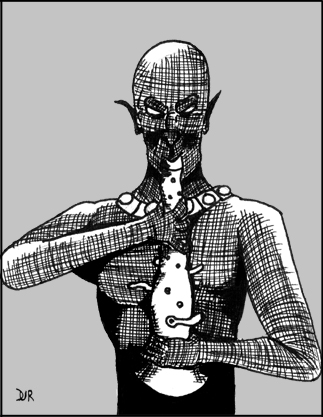 ons (I guess she isn’t completely helpless). A viscous melee follows, with losses on both sides, but the invaders have the advantage of numbers, and the dark skinned giants rout.
ons (I guess she isn’t completely helpless). A viscous melee follows, with losses on both sides, but the invaders have the advantage of numbers, and the dark skinned giants rout.
Cornered in front of the pool, the leader of the creatures breaks his silence in a howl of pure hatred and sacrifices himself into the mystic green waters. The pool erupts in a volcanic geyser, unleashing a sentient wave of death in the freebooters’ direction. Grabbing Sancha, Conan and the rest of the crew make a run for the shore, barely escaping the eerie green river chasing them.
Though ragged and bereft of any bounty, Conan has won the affections of Sancha, the Wastrel and a crew eager for the plunder of more populated waters.
Black Ones
“These creatures were black and naked, made like men, but the least of them, standing upright, would have towered head and shoulders above the tall pirate. They were rangy rather than massive, but were finely formed, with no suggestion of deformity or abnormality, save as their great height was abnormal. But even at that distance Conan sensed the basic diabolism of their features.” – Robert E. Howard, The Pool of the Black One.
Nature DC 15: The creatures known as the black ones are the result of a divergent offshoot of evolution, one that branched from humanity in the dim days of prehistory. There is a marked diabolical influence in their features, and it may be that the black ones are the result of infernal tampering, many ages before the creation of the Tiefling bloodline.
The black ones live in open air cities with glass-like walls, where they enact foul rituals and pursue strange pleasures in the name of their perverse religion. It is said these cities hold ancient knowledge and treasure for those brave enough to risk the black ones’ wrath.
Nature DC 20: The black ones have no spoken language and communicate with one another telepathically. Although it is possible for them to speak with other creatures in this manner, their disdain for all other intelligent life makes the idea repulsive to them. Legend holds that the leaders of the black ones are capable of vocalizing their hatred in an obscene howl that can blast their enemies.
Encounters
It is extremely rare to find the black ones cooperating with other intelligent races. They are xenophobic, whose only contact with other humanoids is to capture victims to sacrifice in infernal rituals. However, these rituals often bind assassin imps, spined devils, and pain devils into service. Though the concept of a pet is alien to them, the black ones have been known to use behemoths as living weapons when the need arises.
Black ones guard their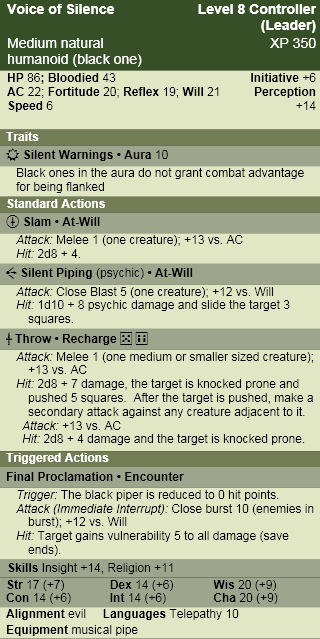 cities with magical traps and hazards, which often feature prominently in their religious practices and blasphemous entertainment.
cities with magical traps and hazards, which often feature prominently in their religious practices and blasphemous entertainment.
Black One Thug
“Conan knew that if he fell foul of that mass of taloned muscle and bone, there could be but one culmination. Once let them drag him down among them where they could reach him with their talons and use their greater body-weight to advantage, even his primitive ferocity would not prevail.” – Robert E. Howard, The Pool of the Black One.
Black One Thugs in Combat
Though they may appear as naked savages to the civilized eye, black one thugs are calm and collected in combat. They have no need for armor or weapons, their own bodies being sufficient to deal with the threats of their environment. When attacking, thugs select the most dangerous adversary in a group, surround, drag them to the ground, and mercilessly stomp the life out of them. Weaker foes are left alive to be captured for sacrifice and loathsome amusements.
Voice of Silence
“One, squatting on his haunches before the cringing boy, held a pipe-like thing in his hand. This he set to his lips, and apparently blew, though Conan heard no sound. But the Zingaran youth heard or felt, and cringed. He quivered and writhed in agony; a regularity became evident in the twitching of his limbs, which quickly became rhythmic.” – Robert E. Howard, The Pool of the Black One.
Voice of Silence in Combat
The voice of silence is the spiritual leader of a community of black ones, presiding over the diabolic rituals around which their strange cities are organized. They focus their mental powers through their pipes, which transmit thought waves instead of sound, and can force the weak willed to dance and jig like a puppet on a string. The voice of silence uses this power in combat to force foes into dangerous hazards and isolate powerful individuals for gangs of black one thugs to overpower.
Notes:
Combined with a hazard or trap (coming soon in part 2) I think that the voice of silence and a group of black one thugs would make a good encounter. Theoretically all sorts of black ones could be created for an extended adventure into one of their cities – a fast skirmisher that can drag off captives (as happened to Sancha), or even an artillery that hurls chunks of broken glass that shatter on impact (that’s not in the story, but I think it fits and it sounds cool).
When I started this project I had intended to use the chronology of the stories as a guide to assigning levels to these creatures (and I’ll still keep that in mind), but that doesn’t always translate well into the game. Most accounts put The Pool of the Black One fairly late in Conan’s career, but the piratical adventure just didn’t seem like paragon tier material to me, so I kept it to the high heroic level. For a paragon version of these creatures I would probably (in addition to upping the damage and attack bonus) add slow (save ends) to the silent piping, daze (for 1 round) to the throw, and a bonus to damage for the thugs if more than two of them are adjacent to a character (like gnolls).
The Slithering Shadow
February 24, 2011The Slithering Shadow features many elements that became synonymous with weird fantasy and were later incorporated into D&D: radiant gems, cultures that are near extinct thanks to their own decadence (the yuan-ti, kopru and bullywugs come to mind), and horrible monsters worshipped as gods. In fact, almost everything from the module B4 The Lost City is taken directly from this story (the desert, the adventure hook, the drug use and even the monster at the end). For these reasons the story is worth reading (and is exceedingly readable), there was just one thing that irked me – Natala, the female protagonist. Even more than the last story (where Yasmela is at least a capable ruler), Natala is a one dimensional damsel in distress. I don’t think the character ruins the story, but it’s unfortunate, since I know Howard is a better writer than that.
One last thing, I’m not really sure what ‘cosmic lust’ is, but the line is used in this story and has forever been linked to The Slithering Shadow’s monster… and just might be the inspiration for countless Japanese hentai movies.
Spoiler Alert! All of these Hyborian age posts are going to be filled with spoilers. From the summary, to the monster stats they are going to ruin any surprises as to what the monster is, when they pop up in the story and how and why they are killed. You’ve been warned.
Summary
This story takes place sometime in the middle of Conan’s career, during his tenure as a mercenary, probably after the events in Black Colossus.
Conan and Natala, a Brythunian Conan had rescued from a raided Shemitish slave market, find themselves without food and water, lost in the deserts east of Stygia. The pair are all that remains of a failed invasion of Stygia by Almuric, a rebel prince of Koth. With no hope of survival, Conan prepares to spare Natala an agonizing death by dehydration with a merciful sword stroke, but his hand is stayed by the image of a city in the distance.
The strange city is constructed from an eerie, green, glass-like material, and the main gates have been left unlocked. Inside, Natala and Conan find a guard who appears to be dead, but rouses from his torpor and attacks. Conan slays the madman, but the expected alarm isn’t raised, and no one else seems to be about on the city streets.
More exploration reveals other oddities, as well as the beautiful Stygian, Thalis. The stranger takes a liking to Conan, and enlightens the refugees over a meal. An outsider, Thalis came to the city of Xuthal as a child, and learned the city’s strange ways. Xuthal was founded by people from the east, learned philosophers whose science is able to produce food without farms, and radium gems whose touch brings lig ht to a room. But generations of leisure have led the culture to stagnate in decadence. The citizens spend most of their days and nights in a drug induced haze. They worship a horrible monster, Thog, who lives in the catacombs beneath the city and rises to feed on its sleeping inhabitants. That Xuthal’s people would accept death so fatalistically outrages Conan.
ht to a room. But generations of leisure have led the culture to stagnate in decadence. The citizens spend most of their days and nights in a drug induced haze. They worship a horrible monster, Thog, who lives in the catacombs beneath the city and rises to feed on its sleeping inhabitants. That Xuthal’s people would accept death so fatalistically outrages Conan.
Thalis desires Conan to stay, for she sees in the barbarian both a lover and a powerful tool for Xuthal’s conquest. Only the presence of Natala stands in the Stygian’s way, so Thalis kidnaps her and flees to the tunnels underneath the city via a secret passage.
Instead of leaving the bound Natala for Thog, Thalis decides to torture her captive as revenge for the wounds she suffered during the struggle.
Meanwhile, Conan works his way through the maze-like rooms and corridors of Xuthal, fighting with the roused inhabitants on the way.
By the time Conan reaches the catacombs, Thog has already devoured Thalis and is about to take his companion as well. Fearlessly, the barbarian launches into the monster, driving it away from Natala. The brutal battle sends a wounded Thog fleeing to the deepest reaches of the earth and leaves Conan beaten, torn and poisoned.
Together, Conan and Natala stumble their way into a quiet part of the city were the Brythunian is able to administer a stolen draught of golden elixir that purges the beast’s venom from Conan’s body.
Thog of Xuthal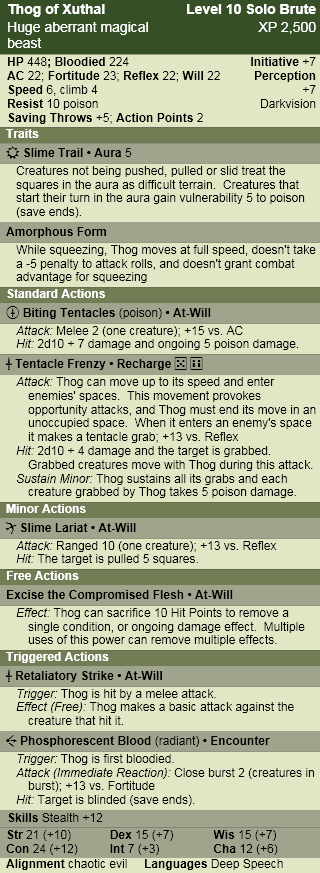
“It towered above him like a clinging black cloud. It seemed to flow about him in almost liquid waves, to envelop and engulf him… The thing seemed to be biting, clawing crushing, and clubbing him all at the same time. He felt fangs and talons rend his flesh; flabby cables that were yet hard as iron encircled his limbs and body, and worse than all, something like a whip of scorpions… tearing the skin and filling his veins with a poison that was like liquid fire.” – Robert E. Howard, The Slithering Shadow
Lore
Dungeoneering DC 20: In a sunken dome in the center of the legendary city of Xuthal, the monster known as Thog slumbers and is worshipped by the degenerate inhabitants as a god. The creature is so old that none can remember if it was brought to Xuthal by the city’s founders, or whether they unearthed it during the city’s construction.
Thog wakes at irregular intervals and stalks the secret corridors and catacombs of Xuthal, feeding on the sleeping inhabitants, who are content to await their doom in lotus dreams.
Thog of Xuthal in Combat
Thog is primarily motivated by hunger, and its preference for feeding on intelligent humanoids seems to suggest the creature needs more than just material nourishment to sustain its alien life. It attacks directly and fiercely, having lived so long it has forgotten the concept of death. In the unlikely event that Thog is gravely injured, it will retreat to its lair, where it is said there lies a well so deep it pierces the heart of the underdark.
Encounters
Thog spends much of its time in slumber, perhaps joining with its followers in one of the dream worlds the culture is so preoccupied with. Despite the creature’s predation, and even though they fear their god to the point of madness, the warriors of Xuthal protect the dome where the creature lairs and react violently to any incursion into the city from outsiders.
When hungry, Thog hunts alone, though creatures it shares a kinship with, like oozes and carrion crawlers, sometimes bubble up from the well in its lair and follow in Thog’s wake.
Notes:
My first solo monster! Many of the monsters Conan fights are solitary, but for some reason it seamed particularly appropriate for Thog to be a solo, especially given Howard’s description of it as “an aggregation of lethal creatures” (which mechanically is exactly what a solo creature is). I made it a level 10 challenge because I thought the monstrous god of a half-ruined city would be the perfect capstone to a series of heroic tier adventures.
I have to admit that creating a solo creature was difficult. Since each solo represents the xp of 5 normal creatures, there’s a lot expected out of a solo monster. I tried to follow Sly Flourish’s recommendations in ‘4 things every solo monster should have’, which I think is good advice, but may be a little heavy handed with the status effect protection. It’s true that a single daze or stun has a much greater impact on a solo encounter then it would in any other encounter, and could make a challenging fight into an unmemorable cakewalk, but take away these effects too indiscriminately and players will feel ripped off. What’s more, they’ll stop choosing those powers in favor of simple damage attacks, which also leads to boring combats (and nobody wants that). That’s why I chose to use the mechanic that I did. Challenge ruining effects can be ended, but at a cost (and only on the monster’s turn), and one I feel doesn’t leave the players feeling cheated. For the record I also think that Sly Flourish’s example is a good one, it’s just hard to apply some of the things he used to my case since he was working with an epic level monstrosity while I was looking to create a heroic challenge.
Black Colossus
February 3, 2011Black Colossus is most well known for containing many of the ideas and plot points that Howard later re-used for his Conan novel The Hour of the Dragon, but is, I think, an excellent story on its own. In particular, I love the introduction. It perfectly captures the feeling and tone of something that would later become integral to D&D: exploring dangerous, ancient ruins and disarming deadly traps.
Spoiler Alert! All of these Hyborian age posts are going to be filled with spoilers. From the summary, to the monster stats they are going to ruin any surprises as to what the monster is, when they pop up in the story and how and why they are killed. You’ve been warned.
Summary
In the three-thousand year old ruins of Kuthchemes, a Zamoran master thief breaks the seal on a strangely preserved ivory dome and releases the wizard Thugra Khotan from his long slumber. Thugra assumes the identity of ‘Natohk the veiled one’ (how very Alucard of him) and raises a horde of desert nomads and elite Kushite warriors. Hungry for conquest and revenge against the Hyborian peoples that overran his kingdom so long ago, Natohk heads north, towards the kingdom of Khoraja.
Before his army reaches its first target, Natohk torments Khoraja’s ruler, the princess Yasmela, with his dark magic. Desperate, Yasmela goes to the temple of Mitra for guidance. Here, the voice of the god tells the princess that her and her people’s only hope is for her to go into the street and place her kingdom in the hands of the first man she meets there.
As fate would have it, she runs into the mercenary Conan whom s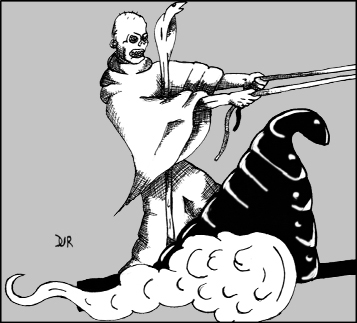 he gives control of the military. The nobles of Khoraja chafe at the idea of being led by a barbarian, but there is little choice, so the army rides out to meet Natohk’s nomads before the city is sieged.
he gives control of the military. The nobles of Khoraja chafe at the idea of being led by a barbarian, but there is little choice, so the army rides out to meet Natohk’s nomads before the city is sieged.
A titanic battle ensues, one where Conan has to face not only Natohk’s sorcery (he uses summoned mists to conceal troop movements and creates magical walls of flame), but also the arrogance and insubordination of Khoraja’s elite.
In the end, Conan’s superior tactics win the battle, but Natohk abducts Yasmela and speeds away on his demon drawn chariot with the Cimmerian in hot pursuit. The sorcerer blames the loss on his lust for the princess and intends to sacrifice her to restore his powers. Fortunately Conan arrives before he is able, hurling his sword and impaling Natohk before he can work any magic (and thus inspiring countless movies and comics where swords have been used as projectiles since).
Thugra Khotan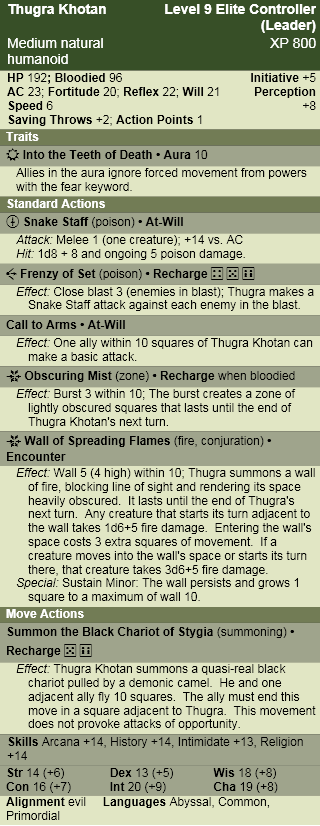
“Natohk faced the Cimmerian – inhumanly tall and lean, clad in shimmering green silk. He tossed back his veil, and Conan looked into the features he had seen depicted on the Zugite coin… Thugra Khotan’s skull-like countenance split in a mummy-like grin.” – Robert E. Howard, Black Colossus.
Lore
Nature DC 15: Thugra Khotan is an ancient Stygian sorcerer who put himself in a deep magical slumber when the city he ruled was overrun by invading barbarians. If he were to awaken, he would surely work to restore his lost glory and take revenge against the nations descended from his enemies.
Thugra Khotan in Combat
Thugra sees himself as a great general and leader of men. He enjoys using his magical abilities to control the battlefield and execute complex strategies and ambushes. His followers obey his orders without question, for they know that Thugra’s displeasure is far worse than anything their enemies can inflict.
The Stygian has no compunctions about withdrawing from a losing battle. After all, armies can be raised, servitors can be summoned, and if need be the sorcerer can seal himself away again and wait for his foes to turn to dust.
Encounters
Thugra Khotan is a master of ritual magic, especially the summoning and binding of demons, and is always accompanied by a barlgura bodyguard. In the years since his city’s downfall, the legend of his power spawned a small but dedicated cult who is now instrumental in recruiting for the sorcerer’s army. The ranks of this horde swell with a motley assortment of bandits, mercenaries, and thugs, lured by the promise of gold, glory and bloodshed.
Most of Thugra Khotan’s targets are well acquainted with the ancient sorcerer long before his minions storm a wall or batter a gate. The Stygian is a master of psychological warfare and takes great pleasure in tormenting his adversaries with sending and other magical forms of intimidation.
Notes
I admit I chose to make Thugra level 9 purely so that he could be teamed up with a barlgura lackey – just like he was in the story (well it wasn’t exactly a barlgura, it was an ape-demon, but I think the barlgura is close enough).
I wasn’t sure if I should make him undead or not since he’s described as looking like a mummy, but I don’t think he was (he was held in stasis in the ivory dome, he had mortal lusts and he was killed by a sword through the chest… I also wanted to differentiate him from a normal D&D lich). If an undead Thugra fits your game better it’s easy enough to change and doesn’t really impact anything.
Finally, the lore check uses the Nature skill simply because that’s the 4e convention for creatures with the natural origin. I think it’s much more appropriate to use the History skill instead (that’s happened before – more and more it looks to me like the knowledge skills and monster origins aren’t lining up as smoothly as I would like in 4e).
The Tower of the Elephant
January 10, 2011Most fans of the Conan stories count The Tower of the Elephant among the best, and I can’t disagree. More important though is the obvious influence this story must have had on D&D. The premise of the adventure is classic D&D stuff: Conan hears a rumor in a bar, forms a party, and braves a monster and trap infested location for treasures which don’t turn out as he expected. And since this story predates the game by a few decades, I guess it would be more correct to say that D&D is classic Conan.
Spoiler Alert! All of these Hyborian age posts are going to be filled with spoilers. From the summary, to the monster stats they are going to ruin any surprises as to what the monster is, when they pop up in the story and how and why they are killed. You’ve been warned.
Summary
From the end of Conan’s career in The Scarlet Citadel, Howard takes us to the beginning, and a much younger and inexperienced Conan. The scene opens on the Maul, a dangerous maze-like section of an unnamed Zamorian city where city guards fear to tread and thieves rule the night. In a dimly lit drinking den Conan hears a Kothian kidnapper gossip of Yara the priest, who dwells in the elephant tower with a great magic gem known as the heart of the elephant. Conan doesn’t understand why a thief with any courage hasn’t simply taken such a treasure yet and the Kothian mocks his naiveté. Conan (even rawer than we’re used to seeing) takes offence and cuts the cur down where he stands. In the chaos following the fight, Conan strides out into the night, the target of his adventure clear.
In the gardens surrounding the tower Conan finds he is not alone in his endeavor. There is another trespasser in the garden by the name of Taurus, the self proclaimed ‘prince of thieves’. The two come to an agreement and proceed together – just in time to dispatch a group of ravenous lions that had been placed in the gardens as savage guards. Conan and Taurus scale the perilous tower and enter, but the lions are not Yara’s only defense. A monstrous spider hiding in the upper chamber poisons Taurus and almost slays the Cimmerian as well. Only Conan’s barbarian instincts see him through the fight alive.
Alone, he continues his quest for the jewel. In one of the tower’s rooms he finds a strange and monstrous creature with emerald skin and the head of an elephant. But instead of a climactic battle with this demon we are given something else. The creature is Yag-kosha, blinded and broken on the r ack – a thing to be pitied. Yag-kosha has been Yara’s prisoner for centuries, working his magic for the priest against his will, unable to escape even by taking his own life.
ack – a thing to be pitied. Yag-kosha has been Yara’s prisoner for centuries, working his magic for the priest against his will, unable to escape even by taking his own life.
The elephantine beast came from green Yag, across the cosmos, while Conan’s people were still primitive ape-men (the same Yag the seeds of Yogtha the Devil Flower were scattered from). Slowly, over vast spans of time his people died out until only Yag-kosha was left, now a shadow of his former self, indentured to the cruel tyrant Yara.
Yag-kosha sees in Conan a means for both liberation from his torture and revenge on the man who inflicted it. He instructs the barbarian to put him out of his misery by cutting out his heart and pouring the blood on the magical jewel he is linked to (the treasure Conan has risked so much to claim). The bloody task complete, Conan is to find Yara and present him with Yag-kosha’s final ‘gift’.
Not one to be squeamish about such tasks Conan obliges Yag-kosha and does as he was instructed. Taking the gem, Conan finds Yara in the haze of the yellow lotus. The dark priest is hostile and outraged at having his meditations disturbed, but goes silent when Conan delivers the heart of the elephant. The strange jewel enspells Yara, shrinking him to diminutive size before absorbing him. Inside the glass walls of the fantastic jewel Conan watches Yara trembling before a fully restored Yag-kosha.
Not sure if what he had experienced was real or not Conan steals away from the tower empty handed as the imposing tower shatters with the first rays of the sun.
Yag Starcaster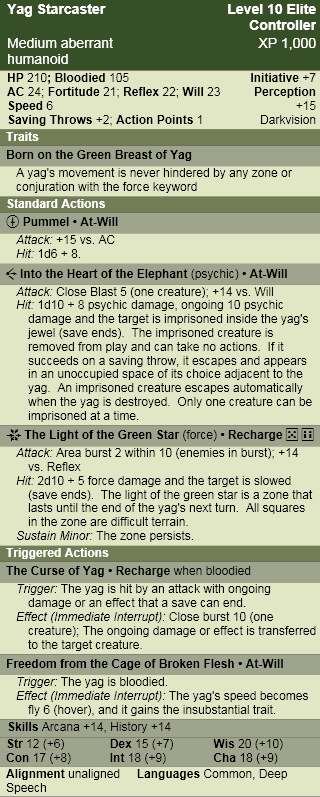
“Conan stared aghast; the image had the body of a man, naked, and green in color; but the head was one of nightmare and madness. Too large for the human body, it had no attributes of humanity. Conan stared at the wide flaring ears, the curling proboscis, one either side of which stood white tusks tipped with round golden balls.” – Robert E. Howard, the Tower of the Elephant
Lore
Dungeoneering DC 15: The Yag are a race of elephant headed, alien beings from the green star of the same name. Each Yag is bonded to a crystal, through which it works powerful magic. The Yag are extremely long lived, so much so that many consider them immortal and worship them as gods.
Dungeoneering DC 20: A Yag can die, but destroying its mortal shell merely frees the creature’s powerful, winged spirit. It is not known what caused the Yag to flee their home, but it must have been an awesome threat both physically and spiritually to send these beings across the void between the worlds.
Yag Starcaster in Combat
Yag are emotionless and methodical in combat. These creatures know that their physical forms are nothing but imperfect reflections of the spirit. For this reason a Yag does not fear death, and in many cases may even welcome it, if it furthers the creature’s goals.
Encounters
Yag are often the leaders of strange star-worshipping cults, perfecting their ancient magic and teaching it to their followers. They care little for the politics of the ‘lesser races’, but the pursuit of their alien goals often brings them and their followers into conflict with outsiders.
It is rumored that powerful star pact Warlocks can ritually bind a Yag into servitude. Such tales usually end with the Yag wreaking bloody vengeance on the Warlock who bound it.
Notes
I really liked the idea of the Yag shrinking PCs down and trapping them in its gem (what we used to call ‘minimus containment’, back in the day), so I cribbed parts of the devourer’s trap spirit ability to make it work. Since the creature is supposed to get more powerful when it dies I thought about making its freedom power work when it got to 0 hit points and adding a healing ability to it, but elite creatures have enough hit points already (especially since it gains insubstantial, it had the potential to make the combat too long). I figured making it ‘die’ when it got bloodied was probably a better call (and makes the creature die and be reborn at a better point in the combat).
I used dungeoneering for the lore check simply because that’s the 4e convention for creatures of the aberrant origin. If you’re not married to that convention then I would recommend using arcana instead, it just seems more appropriate for the astrological/alien bent of this creature than dungeoneering does.
